[[“value”:”
Thank you for reading this post, don't forget to follow and signup for notifications!
David Higginbotham
GLOCK began as a revolutionary polymer-framed 9mm upstart. The company made some pretty bodacious claims back in the 80s, but few took “the plastic fantastic” seriously. Now the gun is the most widely used handgun for US law enforcement and dominates the concealed carry and EDC market. So why don’t more people shoot their GLOCK suppressed?
We’re here to fix that. If I had my druthers, every gun would be suppressed. But GLOCKS? There’s no good reason not to. Especially the 9mms. In this article, we’ll be putting a classic through its paces, talking through the mechanics of suppression, and detailing everything you need to take the noise out of Gaston’s magnum opus.
Why Suppress a GLOCK pistol?

My rationale for suppressing handguns goes for many different calibers and makes: noise reduction. While there are other benefits, like recoil reduction, that come with suppression, I shoot a GLOCK 19 relatively flat. For me, suppressing a GLOCK is all about protecting my hearing and allowing for easier communication on the range.
As a bonus, GLOCK 9mm double-stacks have more aftermarket support than any other gun platform (except the AR-15). That makes everything we’ll cover here that much easier. If you are new to suppressing handguns, nothing is more forgiving than a GLOCK 19.
And 9mm is easy to find subsonic. GLOCK’s other calibers are equally easy to suppress, especially those in the naturally subsonic .45 ACP. But .40 S&W and 10mm rounds are much faster—more on that to follow.
Legal Considerations
If you’re considering suppressing a GLOCK, I’d expect that you have a working understanding of local ordinances. Suppressors are regulated as Class III firearms. You will need to submit the ATF’s Form 4 and jump through all the necessary hoops if you haven’t already. While this process is intimidating to many new gun owners, it is not as odious as it seems at first glance. If you can’t own or carry a GLOCK where you live, it may be time to move.
Essential Components for Suppressing Your GLOCK
You have a GLOCK to suppress, yes? That seems like a good place to start. You’ll need a suppressor, but we’ll dive into those in a moment. Those two are big pieces of a larger puzzle.
I always begin with a threaded barrel. I’ve yet to run across a GLOCK in a gun store with a factory threaded barrel. Not once. A quick search on GLOCK’s site for “threaded” returns no results.
There are many good options, though, including these made by SilencerCo. 9mm barrels will be the most common, and the G19 will have the largest selection. The G17 is close behind. Switch into other GLOCK calibers and there is a precipitous drop off in selection.
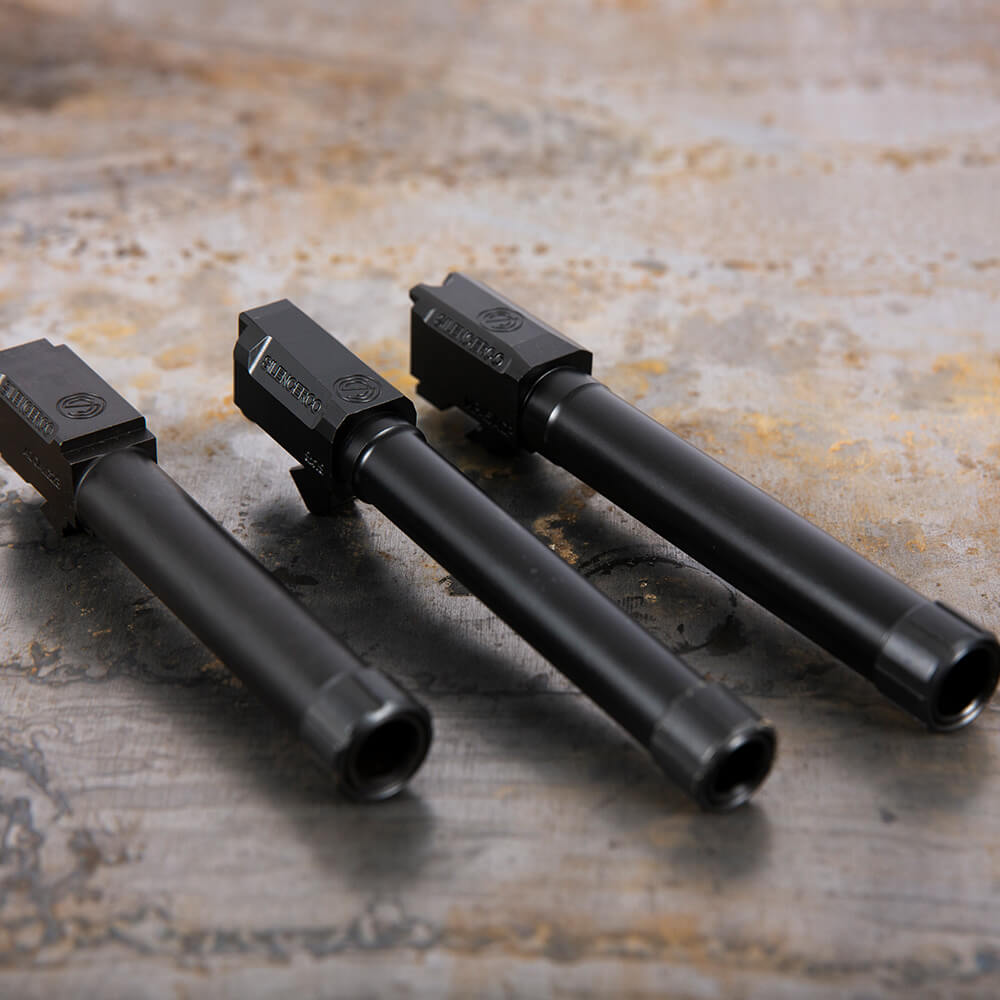
Adding the Threaded Barrel is Easy
Once you have the threaded barrel, it simply replaces the factory barrel. Make sure the gun is empty and separated from its magazine, strip the slide, swap the threaded barrel for the factory barrel, and reassemble. GLOCK is known for its reliability and ease of service, but it has a stellar reputation for modularity, too, so there’s no need for hand fitting or permanent modifications.
Most Likely, You’ll Need a Nielsen Device
Many suppressors offer direct thread options for mounting on threaded barrels. This works for rifles, and for rimfires (even rimfire pistols like the Glock 44), but suppressed centerfire handguns require an additional component: a Nielsen Device.
You may hear these called “boosters” or reductively called “pistons” (and the piston is a part of it), but the highfalutin’ term is Nielsen Device.

I’m going to attempt to dumb down some physics in the explanation of how a Nielsen Device works.
You have the gun on one side and the suppressor on the other, with the Nielsen Device bridging the two. GLOCK handguns run on short recoil actions, meaning the barrel and slide move backward when the round ignites. The slide travels far enough back to eject the spent brass and load the next round. The barrel barely moves to the rear before its travel is interrupted, resulting in the barrel tipping up slightly.

Without a suppressor on the muzzle end, everything in this cycle is balanced. Add the weight of a suppressor, though, and the gun may not cycle correctly. A Nielsen Device rides between the barrel and the body of the suppressor. It contains a spring that sits between the piston (which threads onto the barrel) and the housing (which slides over the spring).
When the gun fires, the barrel bounces back as it normally would. The Nielsen Device’s spring flexes, allowing the suppressor to stay momentarily still, isolating the weight from the critical short recoil cycle. Then, it all snaps back into position, ready for the next round.
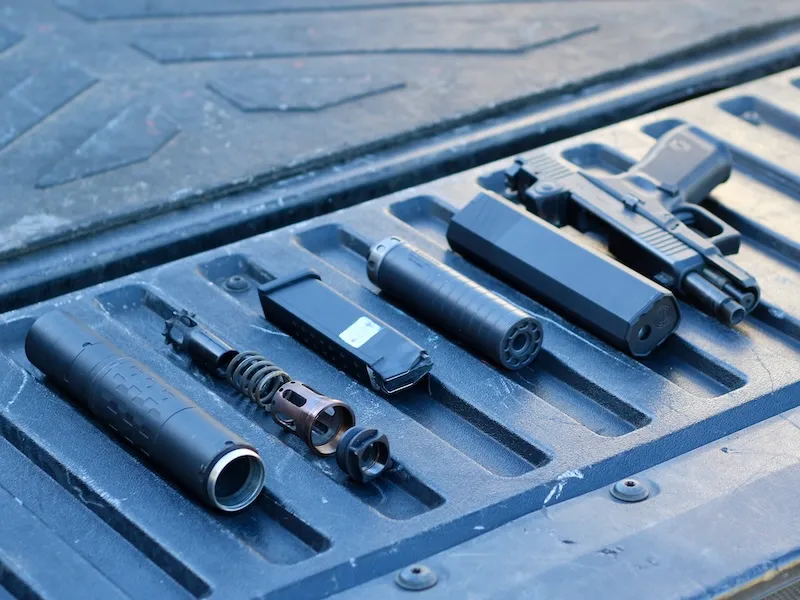
Other Suppressed GLOCK Accessories?
Suppressor-height sights would be my first upgrade. If the suppressor you add blocks your sight picture, getting that gnat’s-ass accuracy becomes more complicated. I highly recommend seeing what you are shooting at.
A red dot that sits up top is easier to add on the MOS GLOCKs, but red dots fail, and suppressor-height or co-witness sights are a sound investment. Because we’re talking about GLOCKs, your choices are endless..
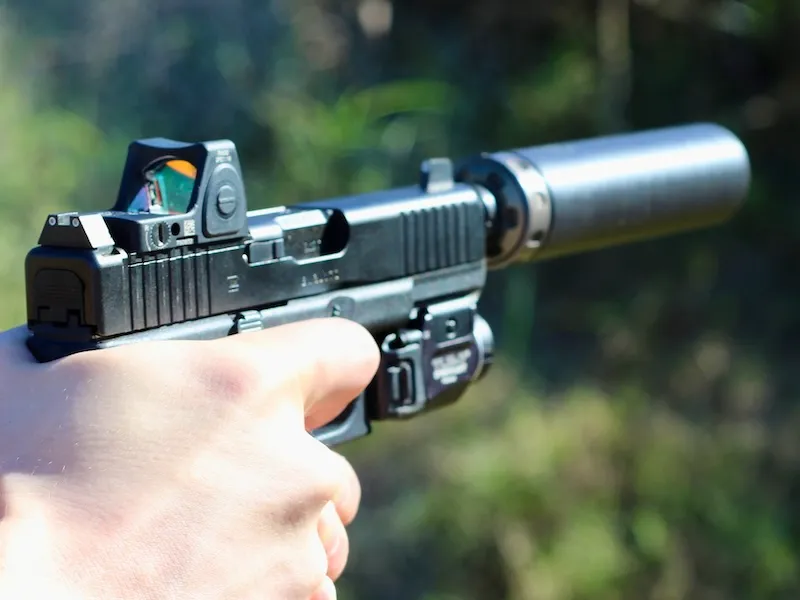
Some gun makers, even some GLOCK clone manufacturers, will include different recoil springs for shooting suppressed. I have never used these on handguns, but I know people who swear by them. I wouldn’t consider them a must unless you have serious difficulty getting subsonic ammo to cycle appropriately.
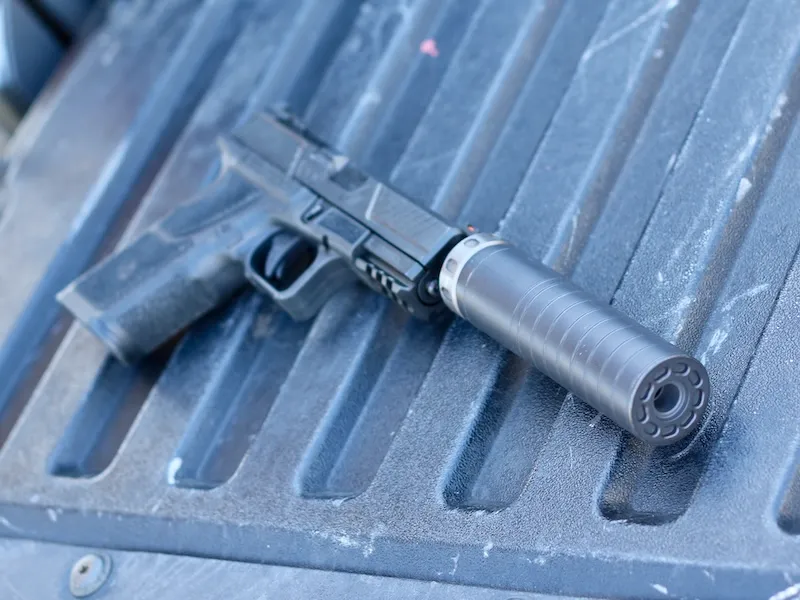
Choosing the Right Suppressor for 9mm GLOCKs
We’ll begin this section identifying a few key considerations. Which of these factors takes precedent for you will determine which of SilencerCo’s suppressors would be a logical fit.
For me, I look for effective noise reduction first. I want a suppressor to bring a 9mm or .45 ACP down to where the noise is no longer damaging to hearing. That said, all of these suppress noise remarkably well.
If you are hunting with your gun, the added length and weight may be more significant.
Or you may be looking for a suppressor to tackle multiple guns or have a full-auto rating. If true versatility is an important factor, there are options that can tackle a vast array of calibers.
Spectre 9 — Light as a Ghost
For those looking at weight, the Spectre 9 (a lightweight titanium suppressor) is a sound choice. The Spectre 9 is compact, narrow, light, and quiet. For any 9mm GLOCK, I’d put this in the top spot.

Osprey 2.0 — a Tested, if Eccentric — Design
SilencerCo’s Osprey 9 is in its second generation and has a proven design that shifts the bulk of the suppressor below the bore axis. This eccentric design allows for better sight picture.
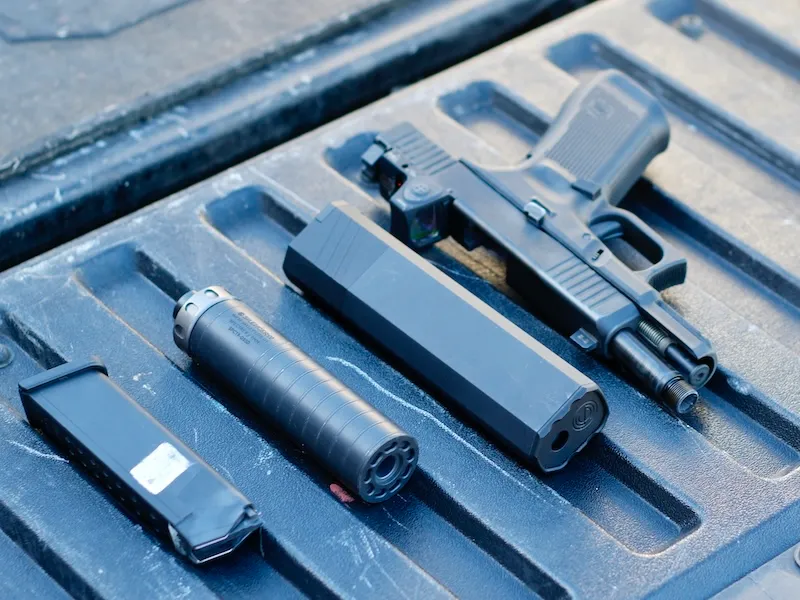
S98 — About as Compact as it Gets
There’s a new dedicated 9mm suppressor coming, the S98, that uses the form factor of the Osprey, but sheds weight and size by relying on welded titanium baffles. It looks to be compact and light. You can see it in action in the video above.
Omega 9K — Sub-Gun Spectacular
For those who want a traditional, clean look, the Omega K Series are ideal cans for 9mm and .45 ACP. If I wanted a suppressor that could suppress a GLOCK 9mm and a 9mm PCC or sub-gun, this would be my choice.
Omega 36M and Hybrid 46M — Big Bore Versatility
Moving up into a class of suppressors that are even more versatile, I’d suggest the Omega 36M or Hybrid 46M. While I think of these are suppressors designed for rifles, they’re just as at home on a GLOCK.
If you need one suppressor that will cover just about everything, both of these are standouts. The Omega 36M is a modular design that shines on .30 caliber rifles and 9mms. The Hybrid 46M can suppress fat rounds like the .45 ACP and .45-70, but will also work on 9mm. It will even work on rimfire.
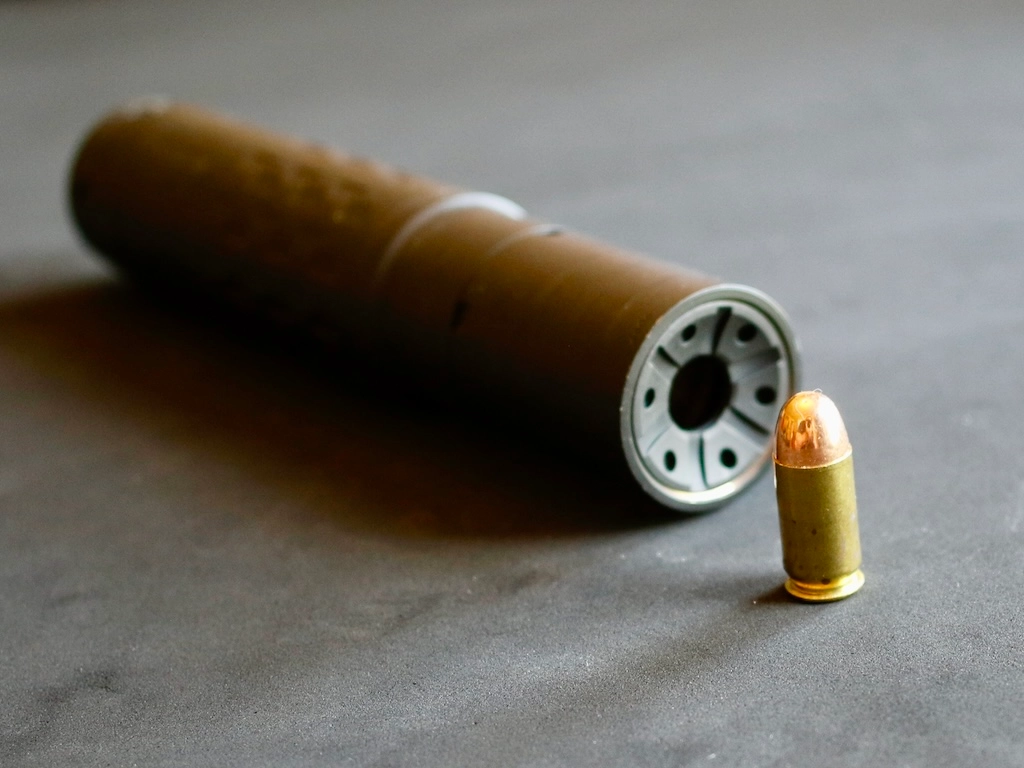
What’s the Best GLOCK to Shoot Suppressed?
You already own a GLOCK, no? I thought everybody did. Is it a G45? If not it should be.
I’ve been a dedicated G19 guy forever. A long time. I have nothing against the G17 length guns, but I like to carry the G19 OWB and AIWB. It didn’t feel perfect when I began training with it, but I grew to understand and respect the design.
And then I found the G45. This, for me, was a Goldilocks moment. The extra grip length balances the G45 perfectly for me. With a threaded barrel, it comes out to the length of a G17, but doesn’t carry that extra bit of weight. And it is an ideal gun to shoot suppressed, as all of the G19 barrels and accessories work with the design.
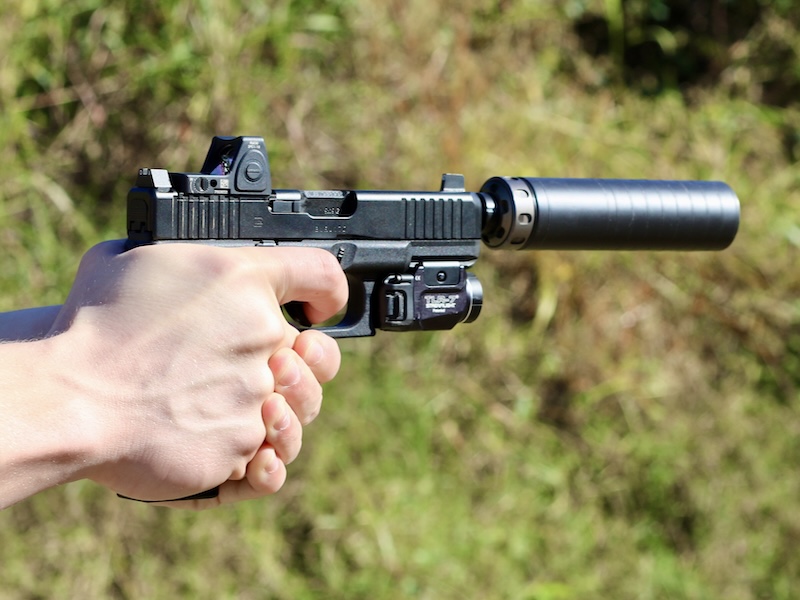
Suppressing Other GLOCKs
The exceptional variety of 9mm ammunition on the market has all but killed off .40 S&W. Still, the G23 is a solid gun. Handgun hunters and those who carry in big bear country love the 10mm. For both of these, my choice would be the Hybrid 46M. This is an ideal suppressor for the wider projectiles and increased pressures that make these guns popular.
For the G21/G41, the Osprey 45 is a solid addition, and the .45 ACP rounds are naturally subsonic.
For the G43 or G48 variants, the S98 is going to be perfect.

Ammo Considerations: Subsonic Optimal Quietness
Let’s talk 9mm. Most 115 grain ball ammo runs above the speed of sound. That means it will crack when fired as the round clips the sound barrier. Heavier 9mm rounds, though, hang under that level.
147 grain 9mm in a GLOCK 19 or 45 has a muzzle velocity of 950—1,000 FSP. While fast enough to provide effective terminal ballistics, it isn’t so fast that it will require extra hearing protection to shoot suppressed.
For my range sessions for this article, I shot Federal’s American Eagle. I can easily tell the 147 grain rounds from the rest of my hodge-podge 9mm ball as it has a distinctly flat nose shape. This keeps me from mixing up mags and running fast ammo through a suppressed G45.
Don’t expect your GLOCK to be Hollywood quiet. If you up your 9mm grain weight to get even slower rounds or go for an ammo that backs off the powder load to drop the muzzle velocity, it can get even more subdued.
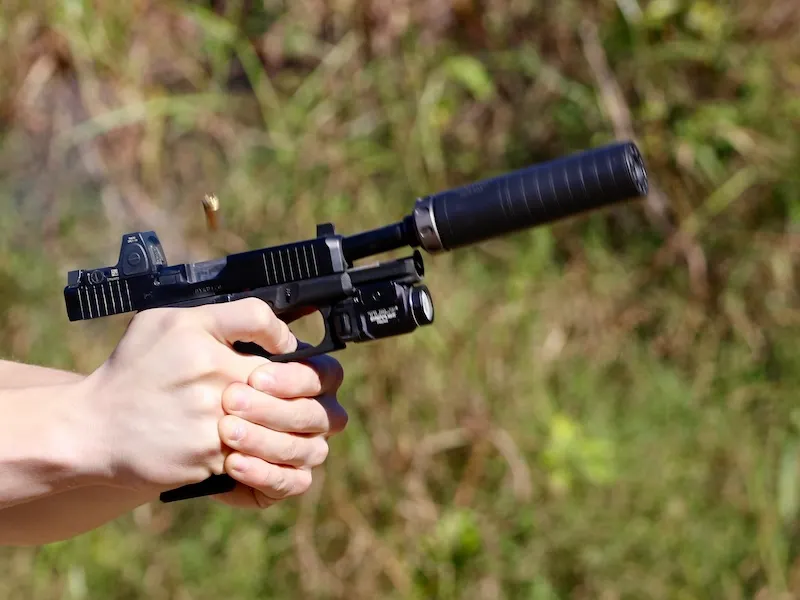
Maintenance and Troubleshooting
After you’ve picked your suppressor, added the Nielsen Device, and added it to your GLOCK, the next step is to function test with your chosen ammo. You’ll want to do this at the range, for obvious reasons.
Pulling the trigger the first time will let you know how it sounds and how it cycles. I’ve found some aftermarket barrels are sticky at first. If your GLOCK doesn’t cycle correctly, unload it, remove the suppressor, and run a couple of magazines down range (while wearing hearing protection). Empty the gun, reinstall the can, and try it again.
I’ve never needed more than 10 rounds to get a GLOCK 9mm smoothed out. How well it cycles, though, could also be related to the ammo. True subsonic ammo may turn this gun into a single-shot, but it will be very quiet. Stick with 147 grain rounds and it should function fine.
When it comes to cleaning, I’m pretty slack. I don’t clean many of my handguns. I’ve sung this song before, but I have a G19 that has 30K +/- rounds through it that I’ve never cleaned. It runs fine. I clean my old Python, and a 1911 (made in 1913), but I don’t want to clean my GLOCKs.
Suppressors need maintenance. With most centerfire designs, shooting them is enough. This is why many designs are sealed so that they can’t be taken apart. Rimfire cans are another story. If you are concerned about lead fouling inside the suppressor, shoot jacketed ammo. It will shed much less garbage inside the suppressor.
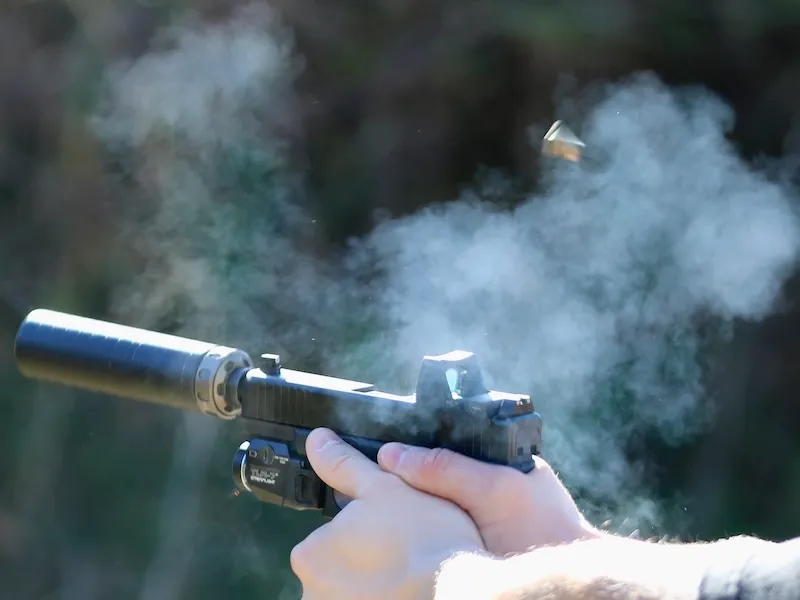
Conclusion
If this is your first foray into shooting suppressed, you’re going to understand why it is so addictive. And GLOCK has to be the easiest of the handgun platforms to begin with. If nothing else, the company has secured its absolute industry dominance by making guns that don’t fail. And this means they’ll run suppressed.
Protect your hearing. Shoot with friends. Teach. Pass on these skills. There’s no better way to be on the range with others than shooting suppressed. It improves the ability to communicate and helps everyone maintain situational awareness.
If you haven’t already, pull the trigger on a suppressor. Get that Form 4 process started. Transform your GLOCK.
David Higginbotham
The post GLOCK® Suppressed: Everything You Need to Know appeared first on SilencerCo.
“]]



